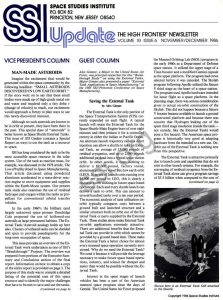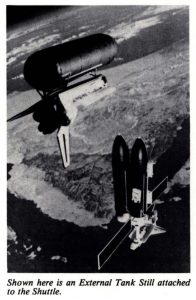SPACE STUDIES INSTITUTE
P.O. BOX 82
PRINCETON, NEW JERSEY 08540
[[librarian note: This address is here, as it was in the original printed newsletter, for historical reasons. It is no longer the physical address of SSI. For contributions, please see this page]]
SSI UPDATE
THE HIGH FRONTIER® NEWSLETTER
VOLUME XII ISSUE6
NOVEMBER/DECEMBER 1986
VICE PRESIDENT’S COLUMN
MAN-MADE ASTEROIDS
Imagine the excitement that would be generated within the space community by the following headline: “SMALL ASTEROIDS DISCOVERED IN LOW EARTH ORBIT.” If the story went on to say that these small bodies were made up of high-grade metal ore and water and required only a tiny delta v (change of velocity) to reach, our excitement would approach a frenzy to plan ways to use this newly-discovered resource.
Although no such asteroids are known to be in orbit at present, they have been there in the past. This special class of “asteroids” is better known as Space Shuttle External Tanks. This issue of SSI Update contains a Special Report on ways to use the tank as a resource in space.
SSI has long considered the tank to be the most accessible space resource in the solar system. Use of the tank as reaction mass, for example, was discussed in the 1978 article, The Low (Profile) Road to Space Manufacturing. That article discussed using powdered aluminum accelerated in a mass-driver reaction engine to move equipment and supplies within the Earth-Moon system. Our present tank study also examines the use of residual hydrogen and oxygen within the tanks as propellant for conventional orbital transfer vehicles.
In the early 1960’s the brilliant (and largely unknown) space pioneer Dandridge Cole proposed the use of hollowed-out asteroids as large permanent habitats. The External Tank/Asteroid analogy holds up here also. Clusters of tethered tanks can be shielded and spun to provide pseudogravity for the long-term occupation of space.
This issue provides an overview of the External Tank work undertaken as one of SSI’s “Breakthrough” Projects. The overview was prepared from portions of the Executive Summary and Conclusions section of the final report. The purpose of this study was to compile a detailed listing of the potential uses of this space resource and to identify the major challenges that have to be met to save and use the tanks.
The entire report was given to the members of the President’s National Commission on Space.
Much work remains to be accomplished in this area. Therefore, SSI is preparing to initiate a major research program on the Shuttle External Tank. Some of the areas that will be examined in detail include the ways in which residual propellants can be scavenged from the tank, how taking the tank along into orbit can add capacity to the Shuttle system and ways to prevent the tanks from randomly falling out of orbit after their release.
Means of using the tanks themselves as components of rotating and non-rotating space structures will also be explored. SSI supporters and Senior Associates have done a great deal to advance the use of these “man-made asteroids.” With your continued assistance we will make this special resource available for the human breakout into space.
Gregg Maryniak
GUEST COLUMN
Alex Gimarc, a Major in the United States Air Force, was principal researcher for this “Breakthrough Study” on using the External Tanks. Major Gimarc also presented a paper “External Tank Applications in Space Manufacturing” at the 1985 SSI/Princeton Conference on Space Manufacturing.
Saving the External Tank
by Alex Gimarc
The External Tank is the only portion of the Space Transportation System (STS) currently expended on each flight. A typical launch will retain the External Tank for the Space Shuttle Main Engine burn of over eight minutes and then jettison it for a controlled reentry in either the Indian or Pacific Ocean. An alternate launch trajectory called a direct injection can allow a shuttle to take an External Tank, an average of 15,000 pounds of residual cryogenics, and up to 2,000 pounds additional payload into a typical space station orbit. In other words, it costs nothing to deliver a 69,000 pound, factory tested, aluminum pressure vessel into low earth orbit (LEO). In an era of launch costs running over $4,000 per pound to LEO, this is clearly a resource worth utilizing in future space based operations. Each and every shuttle launch can deliver a tank to orbit. This can amount to several hundred tanks over a ten year period. The economic analysis of tank utilization on-orbit typically compares costs between a ground built and launched structure and a similar structure built on orbit out of the External Tank or parts supplied by the External Tank. These studies alone make External Tank on-orbit applications extremely attractive. There are additional benefits that the External Tank can provide in orbit which cannot be provided by a ground based item. These make the External Tank a better choice for almost every manned space operation currently envisioned.
Why do we need the External Tank? We need it because it will provide the leverage necessary to make future space based operations, industry, and science far cheaper and easier than would be possible without the External Tank.
Interest in the spent stages of launch vehicles has been a part of the American manned space program since the days of Gemini. The United States Air Force proposed the Manned Orbiting Lab (MOL) program in the early 1960s as a Department of Defense space station. It utilized the upper stage of a Titan booster and a modified Gemini capsule as the upper platform. The program had crews selected before it was canceled. The Skylab program following Apollo utilized the Saturn V third stage as the heart of a space station. The program used Apollo hardware intended for lunar flight as a space platform. In the planning stage, there was serious consideration given to actual on-orbit construction of the Skylab. This did not happen because a Saturn V booster became available to launch a ground constructed platform and because there was concern that Hydrogen leaking out of the spent third stage insulation (inside the tank not outside, like the External Tank) would pose a fire hazard. The American space program is historically very good at adapting hardware from the intended to a new use. Onorbit use of the External Tank is nothing new from this perspective.
The External Tank is attractive primarily due to launch costs and capabilities that do not exist in other launch systems. For example, the scavenging of residual cryogenics from the External Tank alone can give a program savings of $3.5 billion when compared to the cost of launching the same cryogenics in the payload bay to support an Orbital Transfer Vehicle (OTV) operation . A partial disassembly of the External Tank on-orbit and construction of a hangar out of the hydrogen tank will eliminate the need to design and launch a maintenance structure in the orbiter.
The capabilities that do not exist with current or planned operations that the External Tank can provide are limited only by the imagination. These have been broken down into the following areas:
1. External Tank Description – What properties of the External Tank can we take advantage of? How is it put together?
2. Tin Can Uses – What can you use a 33 ton, 150 feet long, 27.5 feet diameter, pressure tested, aerospace grade, aluminum can for?
3. External Tank as a Fuels Resource – The use of residual cryogenics available in the External Tank. What value is a rocket engine that burn powdered aluminum? Can you make the External Tank itself into reaction mass for Orbiter Transfer Vehicles?
4. Structures – What can you do with a structure that carries all the loads imposed by two Solid Rocket Boosters plus an Orbiter and carries over 1.5 million pounds of cryogenics at liftoff?
5. Tethers – How can a tether be used in concert with an External Tank to expand capabilities in space?
6. Miscellaneous – What science can you do with a very large bottle for biology? What advantage can be taken of a potential payload diameter of 27.5 feet?
The capabilities provided by the External Tank that are not available elsewhere include large relatively inexpensive masses of aluminum (in excess of 53,000 pounds per tank) in earth orbit, a large factory tested pressure vessel, large diameter payload capabilities with small enhancements of the External Tank, and large enclosed volumes ready for use in orbital storage until needed.
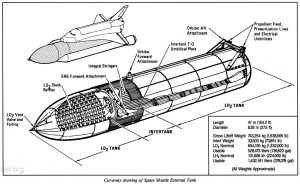
The ramifications that tank utilization can have on the space program in the future are significant. At one stroke, the program changes from one based on limits imposed by high launch costs and relatively small launch and orbital volumes to a program which has started to make use of resources found in space. In this context, the External Tank is a space based resource which is available for use at very low cost. This resource can be adapted to a variety of specialized uses depending on the needs and imagination of the user. This resource is also something that has finely detailed engineering drawings available to the general public and is constructed out of Aerospace/MILSPEC grade materials. This is clearly a very attractive resource.
At the present time, there are several obstacles to the proposed use of the External Tank in orbit. The most significant problems are orbital lifetime (Skylab syndrome), and potential contamination (insulation outgassing). The Skylab syndrome, which is tied to the orbital lifetime of the External Tank, is driven by the desire not to drop large massive objects on the earth in an uncontrolled manner. This is perceived as the primary problem in the use of the External Tank on-orbit. As a result of the altitude of delivery and its size, the External Tank has a finite orbital lifetime due to aerodynamic and solar drag. Any program which will rely on the External Tank has to plan to expend reaction mass of some sort in order to keep the tank in orbit. Orbital lifetimes can be as long as years or as short as days depending on the altitude at which the External Tank is released, the altitude at which it is stored, and the activity of the sun. There are several tradeoffs which can be utilized to solve this problem. First, the residual cryogenics can be used to power low thrust gas burning hydrogen/oxygen thrusters which can boost the External Tank up to a very long lived orbit over the period of a few days. If this is done, little to no recoverable cryogenic residuals will remain in the External Tank, but the External Tank will be in a very long-lived orbit. Second, the orbiter can attach a tether, set up a libration with the External Tank, release at the proper point, and send the External Tank into a much higher orbit and deorbit the shuttle.
Contamination is the second major problem with the External Tank. The entire External Tank is coated with Spray-On Foam Insulation (SOFI) which will outgas on orbit in space. This pollution may not be tolerable in the environment inhabited by the space station. A potential fix is to strip the foam off the External Tank after release in orbit. Most of the foam can be stripped by the equivalent of a hot-wire cheese slicer. The remainder can be polished off by leaving the External Tank ‘hanging in the breeze’ over the period of a month or two exposed to the molecular oxygen present in the proposed orbits. There are other problems with the External Tank on orbit.
Having more mass and volume available than is required for currently planned operations in orbit are factors. The partial disassembly of a tank has never been attempted in space and needs to be demonstrated. These problems are all solvable and in some cases may not be problems at all but advantages.
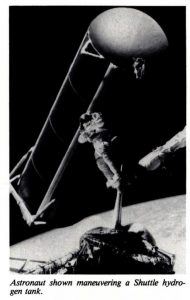
It is clearly in the national interest to do whatever is reasonable to better utilize equipment already purchased. With the External Tank, we have the potential to provide for an enormous expansion in space capabilities for minimal expenditures. With this in mind, the following suggestions are made:
A. Immediately initiate a program to deliver the External Tank into orbit. This program should plan for on-orbit maintenance of the delivered tanks and the possible inclusion of External Tank based structures and modules in the United States Space Station.
B. Quickly arrive at an ownership and sales policy. Suggest sales price be set to reflect only the cost of operating the External Tank orbital storage facility, not an attempt to recover the costs of the entire Space Transportation System.
The rationale here is twofold. First, the External Tank is essentially a salvaged article. Research and Development funds expanded were spent in making the Space Transportation System operational, not in using the External Tank. Second, the ownership issue should be solved quickly and early. This will encourage private investors who want to purchase inexpensive space capability and not feed lawyers. The precedent for this issue comes from the experience with the KC-135. This aircraft was constructed to fill a defense need. The sale of aircraft of the same or a similar design was not constrained by any attempt to recover the cost of monies already spent. Boeing sold no small number of these KC-135 class aircraft to airline companies worldwide as its 707. The net result was an unexpected creation of new jobs, new industries, and the generation of more tax revenues. The utilization of the External Tank will have a similar impact.
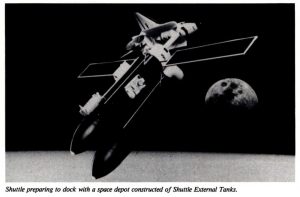
The External Tank is a very important item in the future of this nation in space. It provides the leverage necessary to make large scale space based operations of almost any kind affordable and therefore able to be done privately. The possible applications of the tank on-orbit are constrained only by the imagination. The External Tank should be stored in orbit for future use as soon as possible and the sales and ownership questions settled. This action will likely have an impact on this nation’s future in space comparable to Apollo.
This study was funded by Supporters of the Space Studies Institute, a corporate grant by the Martin-Marietta Corporation, and a significant gift by the Minnesota SSI/L-5 Support Team/Chapter.
We would like to thank Senior Associate Ron Jones for the beautiful slides illustrating this article. Mr. Jones developed a special photo technique to produce the slides and has given SSI permission to use them.
SSI REPLICATORS ANNOUNCED
We are proud to announce the following names have been added to the list of SSI Replicators:
Ann Bennett
Randy Gigante
Steve Morgan
Scott Shjefte
Bob Summersgill
These Senior Associates have signed up either one new Senior Associate, Corporate Member or five new subscribers. Congratulations and thanks to each new SSI Replicator.
SYS-OP WANTED
In an effort to inform a larger number of people of the research we are sponsoring SSI will be initiating a space computer bulletin board. Conference information, meeting notices and research summaries will be appearing on the computer network. We will be participating on a trial basis for one year. If you are interested in being our Sys-op on a volunteer basis please contact the SSI office. Approximately s to d [librarian: that is the origintal text] hours per week would be required to update and monitor the bulletin board. Other requirements include access to a computer and modem. For more information please call the SSI office at xxx-xxx-xxxx during business hours.
The 8th Biennial SSI Princeton Conference on Space Manufacturing
May 6-9, 1987
GENERAL INFORMATION
The 8th Biennial SSI/Princeton Conference on Space Manufacturing, sponsored by Space Studies Institute, is a forum for papers on all aspects of the use of nonerrestrial resources. The program includes papers both on technical aspects of space development and on the social sciences.
In order to accomodate a broad range of presentations, three different types of presentation will be encouraged: 1) the traditional presentation of papers in the auditorium at the Woodrow Wilson School, 2) a poster session and display, 3) an evening roundtable for interaction between participants.
The first three days of the Conference will be open only to registered participants. A summary session on Saturday, May 9 is free and open to all.
CALL FOR PAPERS
Submission of Abstracts
Abstracts of papers received by January 15, 1987 will be considered for inclusion in this Conference. Please limit abstracts to one page with no references. Abstracts and other inquiries should be sent to:
Ms. Barbara Faughnan
Conference Coordinator
Space Studies Institute
Box 82
Princeton, NJ 08540
PEER REVIEW
Voluntary peer review is available. Papers submitted for peer review must be received in entirety by January 15, 1987.
Authors will receive reviewers’ comments for their own information only. Papers will not be accepted or rejected on the basis of peer review.
CONFERENCE PROGRAM
Following is a listing of sessions and session chairmen scheduled for this year’s Space Manufacturing Conference:
Biomedical Considerations
Stanley Mohler
Wright State University,
School of Medicine
Space Manufacturing and Solar Power Satellites
Peter Glaser
Arthur D. Little Company
Artificial Biopheres and Closed-cycle Life Support
Carl Hodges
Environmental Research Laboratory
Social Factors for Space Flight
B. J. Bluth
NASA Headquarters
Nonterrestrial Resources
John Lewis
Lunar and Planetary Laboratory
Space Transportation
Ed Bock
General Dynamics
International and Economic Considerations
Irwin Pikus
National Science Foundation
Poster Session
Morris Hornik
Space Studies Institute
CONFERENCE REGISTRATION
A registration fee of $290 includes lunches, coffee breaks and the Friday night banquet. Pre-registration through the Space Studies Institute is available. If you would like a pre-registration package please send your name, address, and affiliation to: Ms. Barbara Faughnan, Conference Cordinator, SSI. Packages will be mailed in early January.
SSI WELCOMES NEW CORPORATE MEMBERS
We are pleased to welcome two new Corporate Members in this issue of SSI Update. The accounting firm of Amper, Mattia and Politizner which conducts our annual audit and oversees our accounting and the graphics firm Grover’s Mill Graphics which typesets and designs our newsletter have become our newest corporate members. Both firms have been very supportive of our program and helpful in carrying forward the work of the Institute.
©space studies institute

